A D-Band Dual-Polarized High-Gain LTCC-Based Reflectarray Antenna Using SIW Magnetoelectric-Dipole Elements
Abstract
1. Introduction
2. R/R ME-Dipole Element
2.1. Geometry and Operation Mechanism
2.2. Radiation Performance
3. Reflective Phasing Element
3.1. Design of the Reflective Phasing Unit Cell
3.2. Simulated Results of the Reflective Phasing Unit Cell
4. D-Band Reflectarray Antenna
4.1. Design of the Reflectarray Antenna
4.2. Measurement Setup
4.3. Measured Results
5. Conclusions
Funding
Data Availability Statement
Conflicts of Interest
References
- Akyildiz, I.; Han, C.; Hu, Z.; Nie, S.; Jornet, J. Terahertz band communication: An old problem revisited and research directions for the next decade. IEEE Trans. Commun. 2022, 70, 4250–4285. [Google Scholar] [CrossRef]
- Kok, M.; Smolders, A.; Johannsen, U. A review of design and integration technologies for D-band antennas. IEEE Open J. Antennas Propag. 2021, 2, 746–758. [Google Scholar] [CrossRef]
- Huang, J.; Encinar, J. Reflectarray Antennas; Wiley: Hoboken, NJ, USA, 2008. [Google Scholar]
- Massaccesi, A.; Bertana, V.; Beccaria, M.; Marasso, S.; Cocuzza, M.; Dassano, G.; Pirinoli, P. Three-dimensional-printed wideband perforated dielectric-only reflectarray in Ka-band. IEEE Trans. Antennas Propag. 2023, 71, 7848–7859. [Google Scholar] [CrossRef]
- Wu, M.; Li, B.; Zhou, Y.; Guo, D.; Liu, Y.; Wei, F.; Lv, X. Design and measurement of a 220 GHz wideband 3-D printed dielectric reflectarray. IEEE Antennas Wirel. Propag. Lett. 2018, 17, 2094–2098. [Google Scholar] [CrossRef]
- An, W.; Xu, S.; Yang, F. A metal-only reflectarray antenna using slot-type elements. IEEE Antennas Wirel. Propag. Lett. 2014, 13, 1553–1556. [Google Scholar] [CrossRef]
- He, Y.; Gao, Z.; Jia, D.; Zhang, W.; Du, B.; Chen, Z. Dielectric metamaterial-based impedance-matched elements for broadband reflectarray. IEEE Trans. Antennas Propag. 2017, 65, 7019–7028. [Google Scholar] [CrossRef]
- Deng, R.; Yang, F.; Xu, S.; Li, M. A 100-GHz metal-only reflectarray for high-gain antenna applications. IEEE Antennas Wirel. Propag. Lett. 2016, 15, 178–181. [Google Scholar] [CrossRef]
- Encinar, J.; Zornoza, J. Broadband design of three-layer printed reflectarrays. IEEE Trans. Antennas Propag. 2003, 51, 1662–1664. [Google Scholar] [CrossRef]
- Nayeri, P.; Yang, F.; Elsherbeni, A. Broadband reflectarray antennas using double-layer subwavelength patch elements. IEEE Antennas Wirel. Propag. Lett. 2010, 9, 1139–1142. [Google Scholar] [CrossRef]
- Deng, R.; Xu, S.; Yang, F.; Li, M. A single-layer high-efficiency wideband reflectarray using hybrid design approach. IEEE Antennas Wirel. Propag. Lett. 2017, 16, 884–887. [Google Scholar] [CrossRef]
- Mohammadi, B.; Nourinia, J.; Ghobadi, C.; Mahmoud, A.; Karamirad, M.; Alizadeh, F.; Mardani, H. Enhanced Reflectarray antenna using elements with reduced reflection phase sensitivity. IEEE Antennas Wirel. Propag. Lett. 2018, 17, 1334–1338. [Google Scholar] [CrossRef]
- Zhao, J.; Fu, C.; Li, H.; Li, F.; Hu, X. A single-layer broadband Ka-band reflectarray using novel windmill elements. IEEE Trans. Antennas Propag. 2022, 70, 11167–11171. [Google Scholar] [CrossRef]
- Qin, P.; Guo, Y.; Weily, A. Broadband reflectarray antenna using subwavelength elements based on double square meander-line rings. IEEE Trans. Antennas Propag. 2016, 64, 378–383. [Google Scholar] [CrossRef]
- Qu, S.; Lu, S.; Ma, C.; Yang, S. K/Ka dual-band reflectarray subreflector for ring-focus reflector antenna. IEEE Antennas Wirel. Propag. Lett. 2019, 18, 1567–1571. [Google Scholar] [CrossRef]
- Han, C.; Zhang, Y.; Yang, Q. A broadband reflectarray antenna using triple gapped rings with attached phase-delay lines. IEEE Trans. Antennas Propag. 2017, 65, 2713–2717. [Google Scholar] [CrossRef]
- Fan, C.; Choi, W.; Yang, W.; Che, W.; Tam, K. A low cross-polarization reflectarray antenna based on SIW slot antenna. IEEE Antennas Wirel. Propag. Lett. 2017, 16, 333–336. [Google Scholar] [CrossRef]
- Miao, Z.; Hao, Z. A wdeband rflectarray antenna using substrate integrated coaxial true-time delay lines for QLink-Pan applications. IEEE Antennas Wirel. Propag. Lett. 2017, 16, 2582–2585. [Google Scholar] [CrossRef]
- Zhang, L.; Zhang, J.; He, Y.; Mao, C.; Li, W.; Wong, S.; Mei, P.; Gao, S. A single-layer 10–30 GHz reflectarray antenna for the internet of vehicles. IEEE Trans. Veh. Technol. 2022, 71, 1480–1490. [Google Scholar] [CrossRef]
- Wang, Q.; Shao, Z.; Li, P.; Li, L.; Cheng, Y. A dual polarization, broadband, millimeter-wave reflectarray using modified cross loop element. Microw. Opt. Technol. Lett. 2014, 56, 287–293. [Google Scholar] [CrossRef]
- Encinar, J.; Datashvili, L.; Zornoza, J.; Arrebola, M.; Sierra-Castaner, M.; Besada-Sanmartin, J.; Baier, H.; Legay, H. Dual-Polarization Dual-Coverage Reflectarray for Space Applications. IEEE Trans. Antennas Propag. 2006, 54, 2827–2837. [Google Scholar] [CrossRef]
- Florencio, R.; Encinar, J.; Boix, R.; Losada, V.; Toso, G. Reflectarray antennas for dual polarization and broadband telecom satellite applications. IEEE Trans. Antennas Propag. 2015, 63, 1234–1246. [Google Scholar] [CrossRef]
- Wu, L.; Hu, Q.; Luo, X.; Zhao, J.; Jiang, T.; Chen, K.; Feng, Y. Wideband dual-feed dual-polarized reflectarray antenna using anisotropic metasurface. IEEE Antennas Wirel. Propag. Lett. 2022, 21, 129–133. [Google Scholar] [CrossRef]
- He, X.; Yang, W.; Liao, S.; Li, Y.; Xue, Q.; Che, W. 140-GHz high-efficiency low-profile reflectarray antenna using heterogeneous design strategy. IEEE Trans. Antennas Propag. 2024, 72, 932–937. [Google Scholar] [CrossRef]
- Ng, K.; Wong, H.; So, K.; Chan, C.; Luk, K. 60 GHz plated through hole printed magneto-electric dipole antenna. IEEE Trans. Antennas Propag. 2012, 60, 3129–3136. [Google Scholar] [CrossRef]
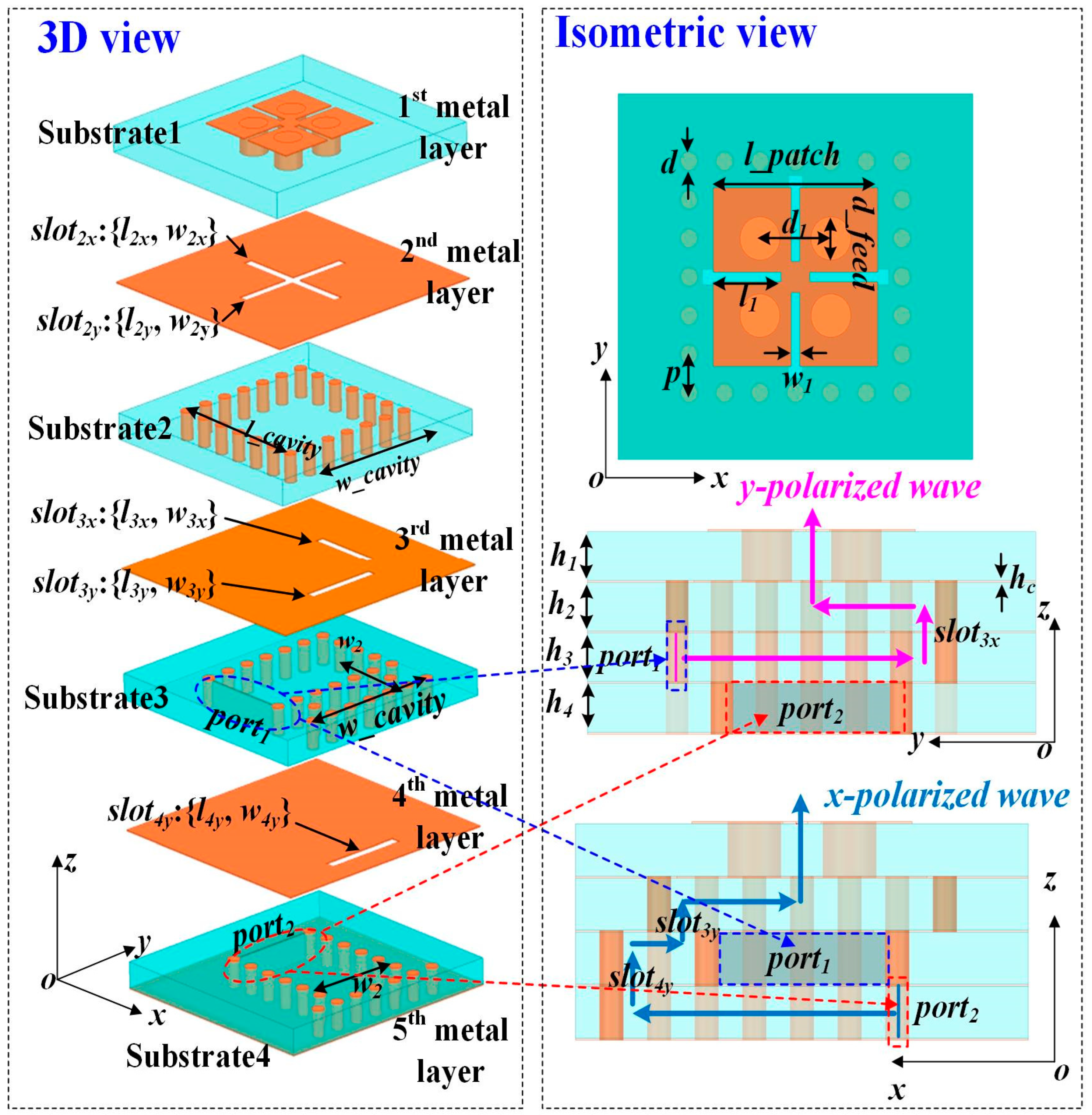




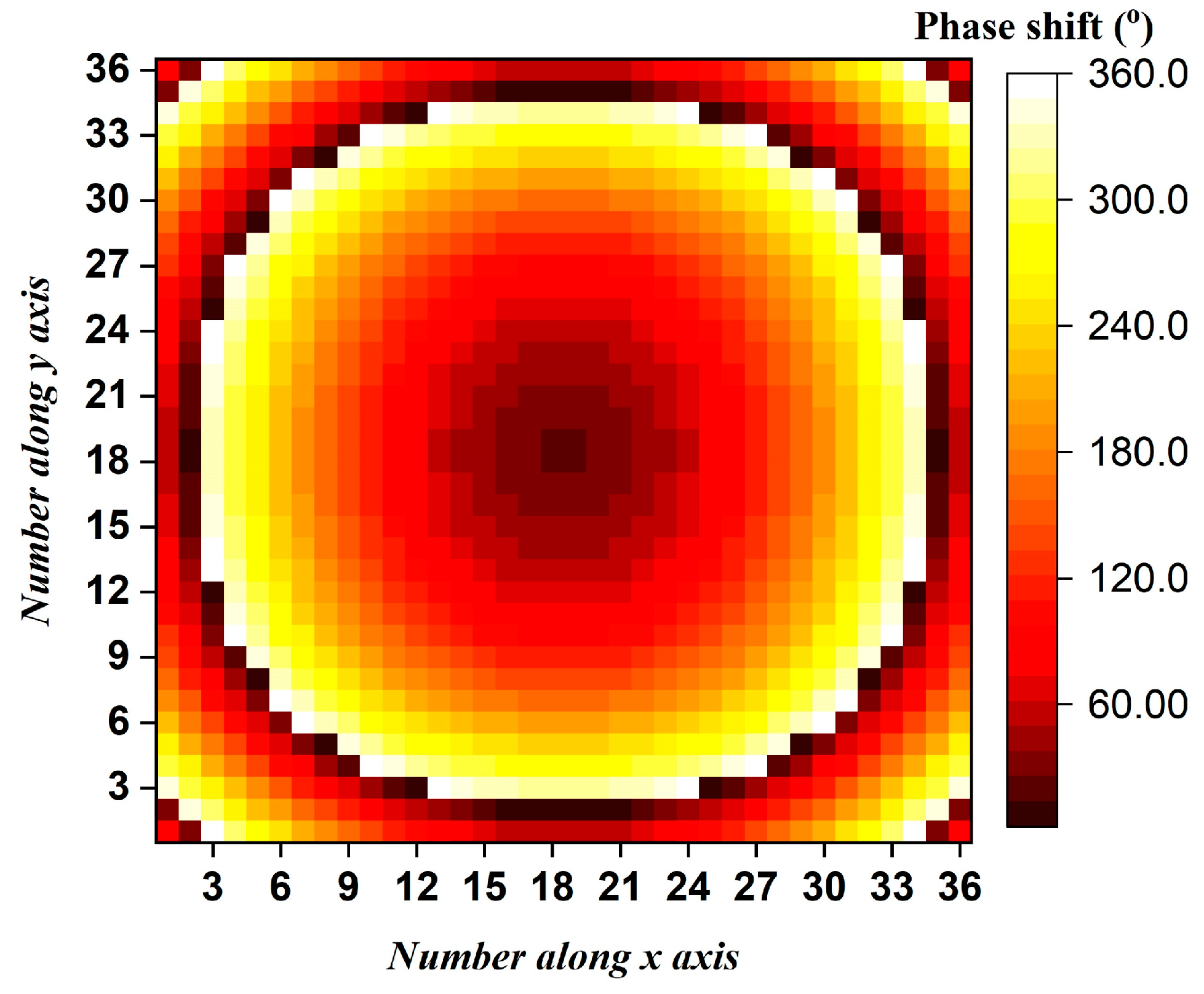
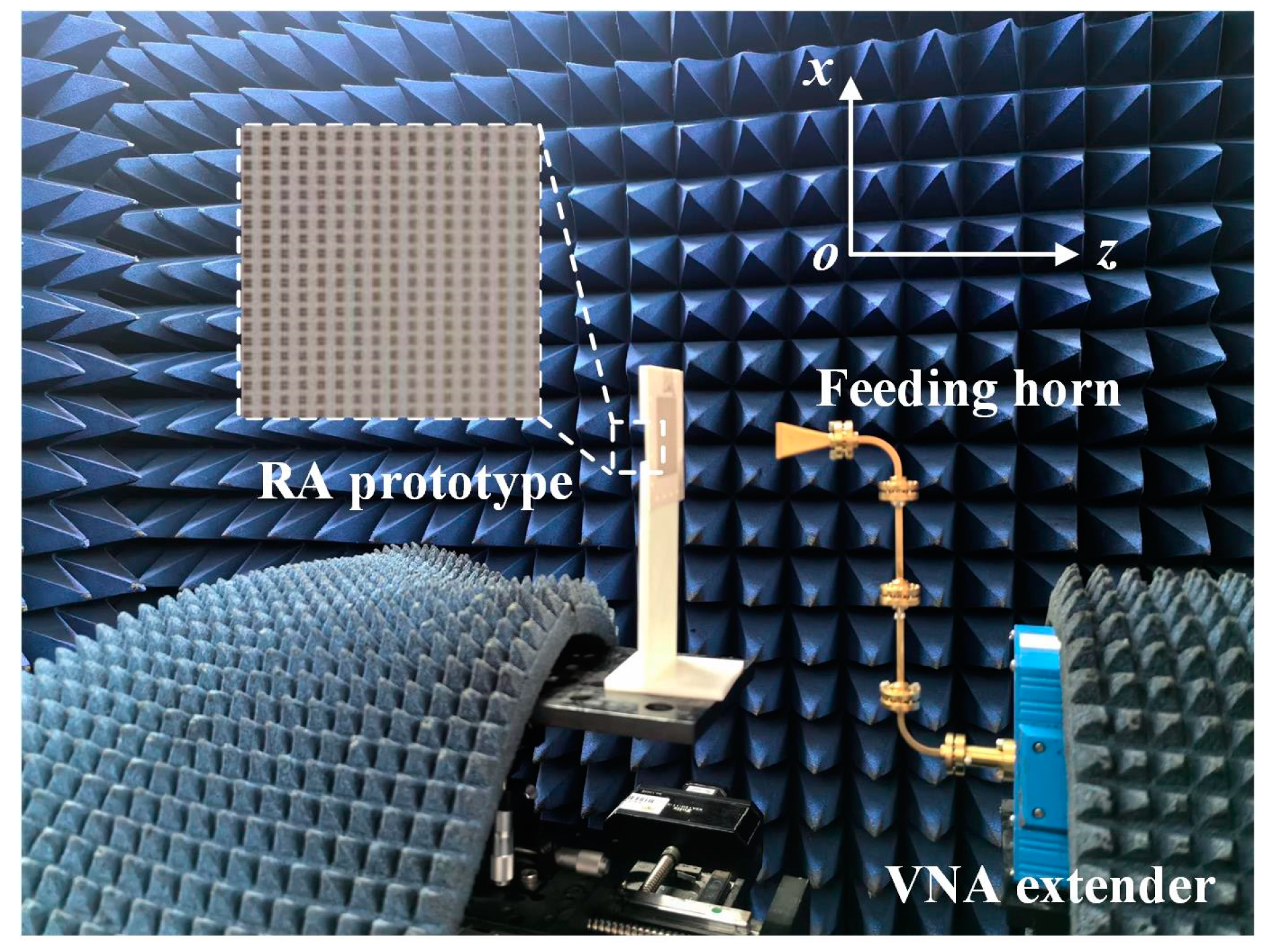
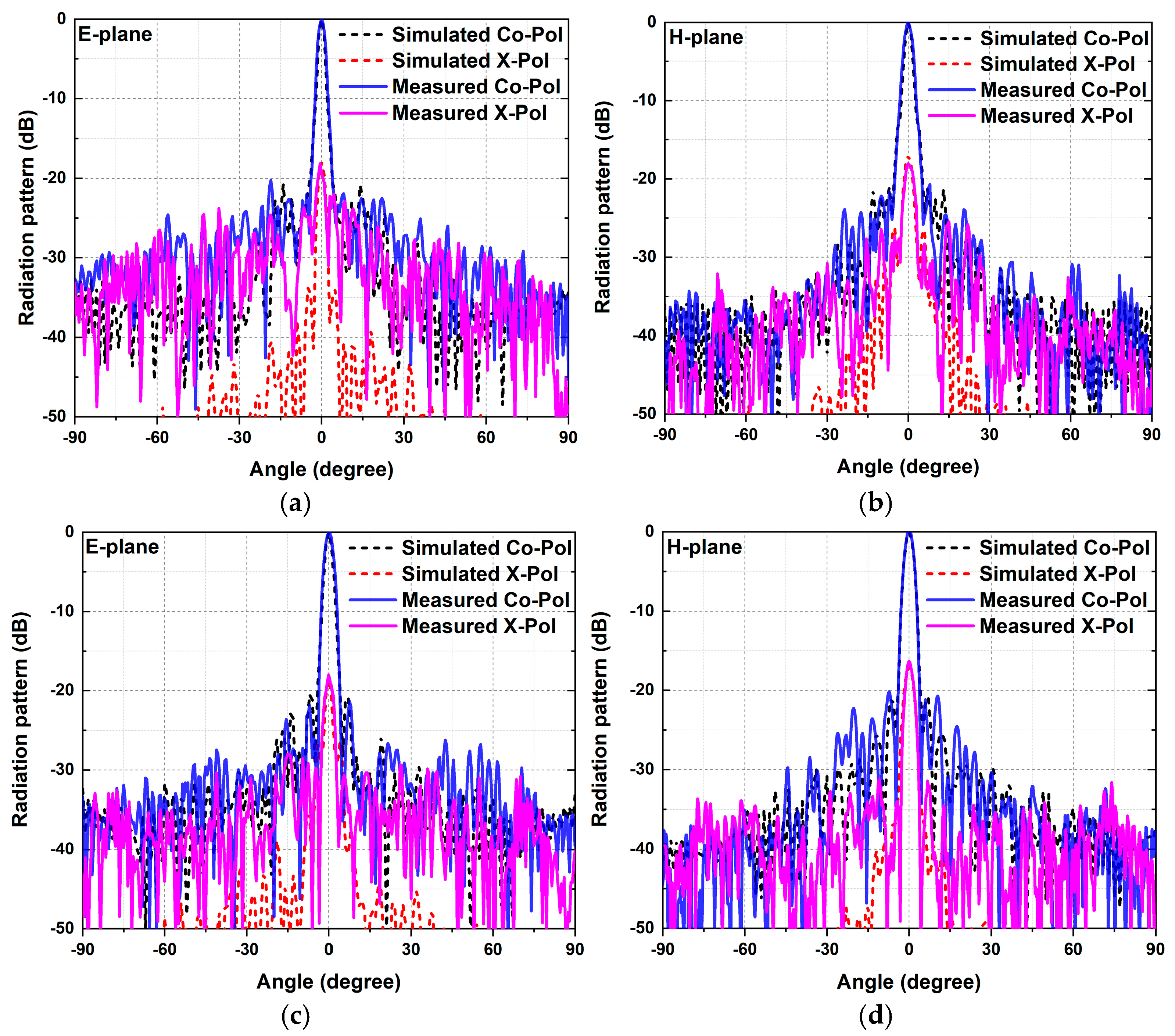
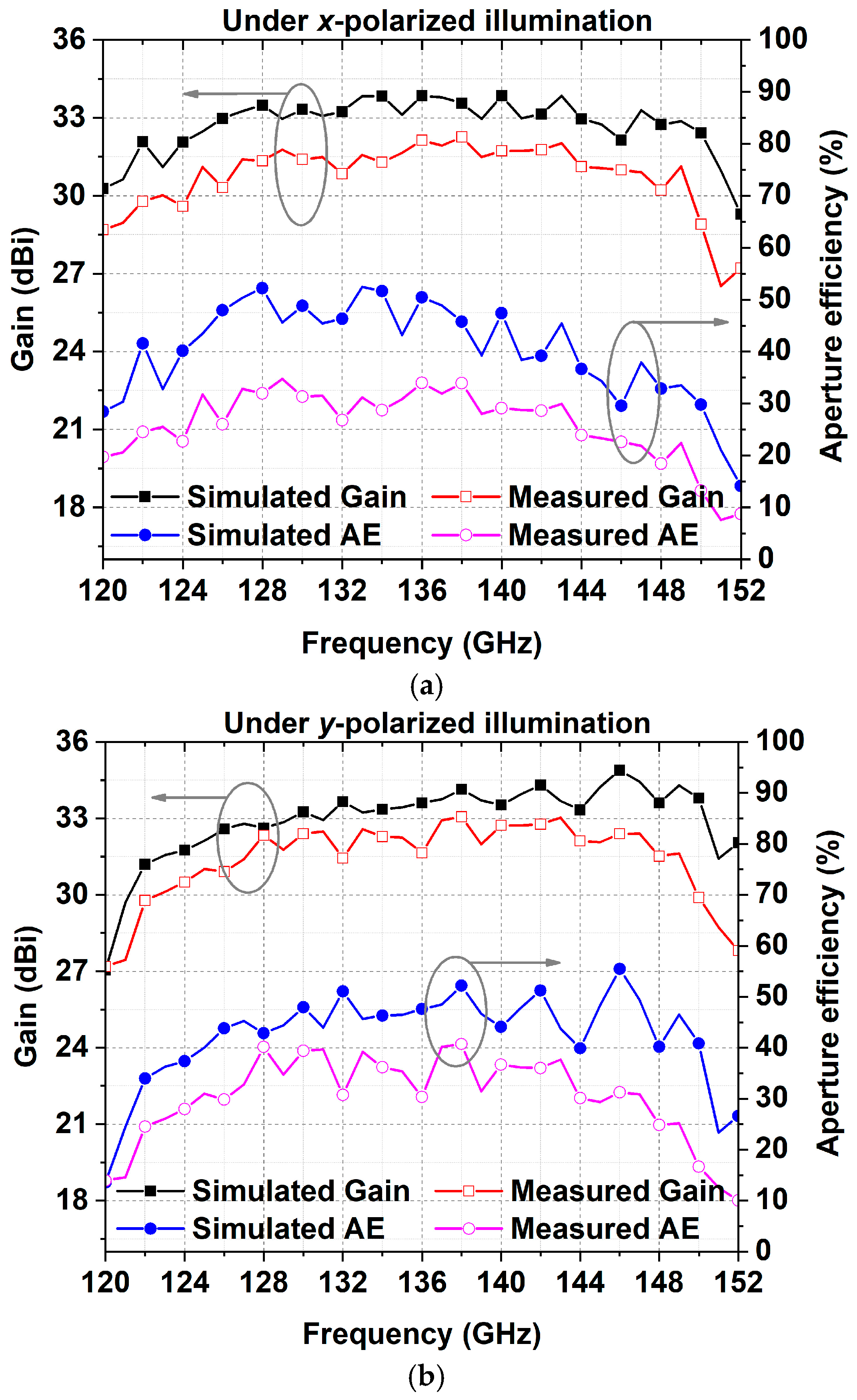
| Parameter | Value (mm) | Parameter | Value (mm) | Parameter | Value (mm) |
|---|---|---|---|---|---|
| l_cavity | 1.2 | w_cavity | 1.2 | p | 0.2 |
| d | 0.1 | l_patch | 0.925 | d1 | 0.4 |
| d_feed | 0.112 | w1 | 0.05 | l1 | 0.382 |
| l1x | 1.05 | w1x | 0.08 | l1y | 1.05 |
| w1y | 0.08 | l2x | 0.65 | w2x | 0.08 |
| l2y | 0.65 | w2y | 0.08 | l3y | 0.7 |
| w3y | 0.085 | w2 | 0.8 | hc | 0.008 |
| h1 | 0.008 | h2 | 0.2 | h3 | 0.2 |
| h4 | 0.2 |
| Reference Number | Polarization | Process | Element Type | f0 (GHz) | Peak Gain (dBi) | AE (%) | Gain Bandwidth (%) |
|---|---|---|---|---|---|---|---|
| [4] | Single linear | 3D Printing | Dielectric cell | 30 | 30.75 | 28.9 | 24.8 (1 dB) |
| [5] | Single linear | 3D Printing | Dielectric cell | 220 | 27.4 | 27.6 | 20.9 (1 dB) |
| [6] | Single linear | CNC | Metallic cell | 12.5 | 32.5 | - | 8.3 (1 dB) |
| [7] | Single linear | PCB | Dielectric cell | 13.5 | 30.2 | 45.6 | 18.1 (1 dB) |
| [8] | Single linear | CNC | Metallic cell | 100 | 28 | 50.1 | 25 (3 dB) |
| [10] | Single linear | PCB | Stacked patch | 32 | 32.55 | - | 19 (1 dB) |
| [11] | Single linear | PCB | Multi- resonance | 12.5 | 33.9 | 67% | 21.6 (AE > 40%) |
| [12] | Single linear | PCB | Multi- resonance | 10 | 26.6 | 44.6 | 23.3 (1 dB) |
| [13] | Single linear | PCB | Multi- resonance | 35 | 27.86 | 51.7 | 35.71 (3 dB) |
| [14] | Single linear | PCB | Sub- wavelength | 10 | 28.2 | 56.5 | 18 (1.5 dB) |
| [16] | Single linear | PCB | Delay line | 10 | 25.78 | 50 | 38.5 (3 dB) |
| [17] | Single linear | PCB | Delay line | 30 | 24 | 48 | 7 (3 dB) |
| [18] | Single linear | PCB | Delay line | 42.5 | 32.83 | 51.18 | 12.94 (3 dB) |
| [19] | Single linear | PCB | Delay line | 20 | 27.51 | 43.8 | 100 (stable radiation pattern) |
| [20] | Dual linear | PCB | Multi- resonance | 32 | 34.3 | 48.6 | 18 (1.5 dB) |
| [22] | Dual linear | PCB | Multi- resonance | 11.95 | 28.82 | 52 | 27 (2 dB) |
| [23] | Dual linear | PCB | Stacked patch | 15 | 24.5 | 37.4 | 15 (1 dB) |
| [24] | Single linear | LTCC | Heterogeneous Strategy | 140 | 31.4 | 46.32 | 6.5 (1 dB) |
| This work | Dual linear | LTCC | Delay line | 135 | 33.03 | 35.38% | 20 (3 dB) |
Disclaimer/Publisher’s Note: The statements, opinions and data contained in all publications are solely those of the individual author(s) and contributor(s) and not of MDPI and/or the editor(s). MDPI and/or the editor(s) disclaim responsibility for any injury to people or property resulting from any ideas, methods, instructions or products referred to in the content. |
© 2024 by the author. Licensee MDPI, Basel, Switzerland. This article is an open access article distributed under the terms and conditions of the Creative Commons Attribution (CC BY) license (https://creativecommons.org/licenses/by/4.0/).
Share and Cite
Miao, Z.-W. A D-Band Dual-Polarized High-Gain LTCC-Based Reflectarray Antenna Using SIW Magnetoelectric-Dipole Elements. Micromachines 2024, 15, 1511. https://doi.org/10.3390/mi15121511
Miao Z-W. A D-Band Dual-Polarized High-Gain LTCC-Based Reflectarray Antenna Using SIW Magnetoelectric-Dipole Elements. Micromachines. 2024; 15(12):1511. https://doi.org/10.3390/mi15121511
Chicago/Turabian StyleMiao, Zhuo-Wei. 2024. "A D-Band Dual-Polarized High-Gain LTCC-Based Reflectarray Antenna Using SIW Magnetoelectric-Dipole Elements" Micromachines 15, no. 12: 1511. https://doi.org/10.3390/mi15121511
APA StyleMiao, Z.-W. (2024). A D-Band Dual-Polarized High-Gain LTCC-Based Reflectarray Antenna Using SIW Magnetoelectric-Dipole Elements. Micromachines, 15(12), 1511. https://doi.org/10.3390/mi15121511








